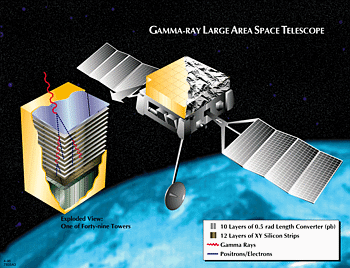One proposal for such a mission, selected for study as a NASA New Mission
Concept in Astrophysics, is the Gamma-ray Large Area Space Telescope (GLAST)
shown in fig. 4.2.
 Figure 4.2 - Artist's concept of the GLAST instrument and spacecraft
.
Figure 4.2 - Artist's concept of the GLAST instrument and spacecraft
.
For the baseline mission parameters given in Table 4.1, a nearly two-order-of-magnitude
improvement in flux sensitivity and a factor of 10 improvement in point
source location capability will be obtained. Determination of the spectra
of the sources over a broad energy range will also be possible. A wide
field-of-view telescope will allow the detection of many more transient
sources such as AGN flares and high-energy gamma-ray bursts.
The principal scientific objectives for the mission include:
- Active galactic Nuclei: determine the mechanisms of AGN jet
formation, particle acceleration, and radiation by studying gamma-ray emission
fromall known blazars (and possibly other AGN classes) and correlating
these observations with those at other wavelengths.
- Unidentified Gamma-ray Sources: determine the type of object(s)
and the mechanisms for gamma-ray emission from the unidentified gamma-ray
sources by measuring precise positions of these sources.
- Isotropic Background Radiation: determine if the high-energy
background is resolvable into point sources or if there is a true diffuse
component, by a deep survey of high-latitude fields.
- Gamma-Ray Bursts: provide constraints on physical mechanisms
for gamma-ray bursts by detecting high-energy radiation from 50 - 150 bursts
per year and studying the GeV : keV-MeV emission ratio as a function of
time; image burst positions to a few arcminutes or better, allowing deep
"real-time" multiwavelength observations.
- Endpoints of Stellar Evolution (Supernovae, Neutron Stars, and Black
Holes): provide direct evidence of proton cosmic-ray acceleration in
supernova remnants by gamma-ray mapping and energy spectral measurements;
distinguish between models for high-energy gamma-ray emission from pulsars
by measuring detailed phase-resolved spectra. Determine whether or not
galactic superluminal jet sources emit significant high-energy gamma radiation.
- Molecular Clouds, Normal Galaxies and Clusters: probe the cosmic-ray
distribution in dense molecular clouds and in nearby galaxies (LMC, SMC,
M31) by gamma-ray mapping and measuring the spectra of diffuse emission
from these objects; search for extended emission from possible cold dark
matter clouds in the galaxy and from galaxy clusters as a signature of
unusual concentrations of unseen gas or cosmic rays.
TABLE 4.1. Characteristics of a High-Energy Gamma-Ray Mission Using
an Imaging Pair Conversion Telescope
| Energy Range |
10 MeV - 100 GeV |
| Energy Resolution |
10% |
| Effective Area |
8,000 cm2 (above 100 MeV) |
| Single Photon Angular Resolution (68% containment angle) |
< 2.5 deg x (100 MeV/E)
(10 MeV - 3 GeV)
< 0.10 deg (E >10
GeV) |
| Field-of-View |
> 1.5 sr |
| Point Source Sensitivity |
2 x 10-9 ph cm-2 s-1 |
| Source Location Determination |
30 arcsec - 5 arcmin |
| Mass |
3,000 kg |
| Power |
600 W |
| Telemetry |
100 kbps |
| Mission life |
> 2 years |
| Orbit |
low inclination |
| Spacecraft pointing |
10 arcsec knowledge < 2 deg accuracy |
| Operating modes |
all-sky survey mode, pointed observation mode, any direction at any
time |
|
Next
Previous
Table of Contents

